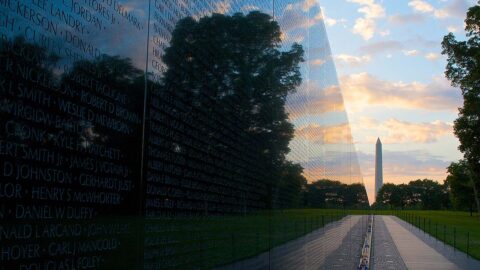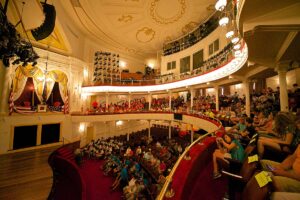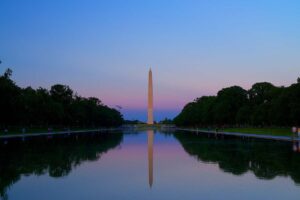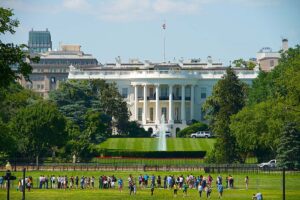Famous Washington DC Landmarks You Must Visit

Welcome to the vibrant heart of America — Washington, DC. This city is not just the political capital of the United States but also a cultural hub rich in history and monuments. This guide helps you navigate the must-visit landmarks in Washington, DC, each with a unique story to tell. Including these landmarks in your trip allows you to immerse yourself in the captivating narratives of America’s past, present, and future.
Exploring the city’s iconic landmarks becomes an effortless and enjoyable experience with the Old Town Trolley. This hop-on, hop-off service offers the flexibility to navigate the city at your own pace while the knowledgeable guides provide insightful commentary, enriching your understanding of the sights. With its comprehensive route that encompasses key landmarks, the Old Town Trolley ensures you won’t miss a thing. Whether you’re gazing at the majestic Washington Monument or delving into history at the Lincoln Memorial, the trolley provides a convenient, informative, and fun way to experience Washington, DC.
The Definitive Tour of Washington D.C.’s Essential Landmarks
The most comprehensive, engaging, and flexible way to visit Washington D.C.’s essential landmarks is with Old Town Trolley Tours.
Why Choose Old Town Trolley Tours for Landmark Sightseeing?
- Hop-on/Hop-off Freedom: Get off the trolley at any of the key stops to explore landmarks like the Lincoln Memorial at your own pace.
- Seamless City Coverage: The route connects the monuments on the National Mall with the government buildings on Capitol Hill, and provides access to Arlington.
- Expert, Live Narration: Certified conductors deliver engaging stories and historical context, not just generic facts or pre-recorded audio.
- Stress-Free Transit: Avoid D.C. traffic and parking costs with continuous, reliable transportation between all major points of interest.
Essential Washington D.C. Landmarks You Will See
- The White House & Capitol Hill: View the official residence of the U.S. President and access the U.S. Capitol Building and Supreme Court of the United States.
- Iconic Monuments: Stop near the majestic Abraham Lincoln Memorial, the towering Washington Monument, and the Thomas Jefferson Memorial.
- National Mall Tributes: Easily reach the World War II, Vietnam, and Korean War Memorials along the National Mall.
- Historic Sites & Museums: Access key places like Ford’s Theatre, the site of Lincoln’s assassination, and the various Smithsonian Institution museums.
Ford’s Theatre

The theater has borne witness to more than just political history. In 1893, a tragic interior flooring collapse resulted in 22 deaths, leading to significant repairs and renovations to ensure the safety and preservation of this historic building. The building transitioned into a museum in 1932, offering visitors a chance to walk the corridors of history. It was again renovated and reopened as a functioning theater in 1968, merging the past and present in a living testament to American resilience and love for the arts.
What To See at Ford’s Theatre
Ford’s Theatre stands as a testament to both architectural prowess and historical significance. The structure itself, designed in an eye-catching Georgian architectural style, captivates visitors with its grand fac̨ade. As you step inside, the theater continues to impress with a blend of old-world charm and modern functionality, carefully maintained through various restorations. The ornate carvings, draperies, and proscenium archway echo the era of Lincoln, creating an atmosphere of nostalgic reverence.
The highlight of a visit to Ford’s Theatre is undoubtedly attending a live performance. The theater offers a regular lineup of plays, musicals, and shows, each one bringing life to the same stage where Lincoln once enjoyed performances. The engaging performances, combined with the theater’s historical ambiance, promise an unforgettable experience.
The theater also houses a museum showcasing a plethora of artifacts related to Lincoln’s presidency, his assassination, and the aftermath. Here, you can see the Derringer pistol used by John Wilkes Booth, Lincoln’s assassin, as well as the blood-stained pillow on which Lincoln’s head rested after the fatal gunshot. The museum also displays various personal items belonging to Lincoln. These artifacts offer a deeply personal insight into Lincoln’s life and his final moments, making for an emotionally moving visit. A tour of this site provides you with a poignant understanding of the impact of this tragic event on the nation.
Ford’s Theatre is typically open daily to the public, but hours can vary based on performance schedules and events, so checking the calendar in advance is necessary. Reservations for tours are recommended due to the site’s popularity.
Go to Washington DC map for the nearest trolley stop.
The Supreme Court of the United States

Considered an architectural masterpiece, the Supreme Court Building is laden with profound historical significance. Its majestic façade and grand corridors echo the weighty decisions made within, decisions that have shaped the legal and social landscape of America. The awe-inspiring building itself features classical Corinthian columns, an elegant marble staircase, and a library housing a wealth of legal knowledge — a testament to the profound intellectual and judicial work that takes place here.
What To See at the Supreme Court of the United States
The building, completed in 1935, is a marvel in itself, adorned with intricate marble carvings, impressive friezes, and stately pillars, exhibiting a powerful blend of function and form. Upon entering the building, visitors are greeted by the Great Hall, a grand corridor lined with busts of past Supreme Court Justices. This space provides a fascinating insight into the legacy of the American judiciary.
The Supreme Court of the United States is open to the public. The Court holds sessions Monday through Wednesday from 10 a.m. to 3 p.m. from October through April, during which visitors can observe oral arguments on a first-come, first-served basis. While no reservations are required for attending these sessions or exploring public areas of the building, a limited number of seats are available, so arriving early is advised.
For those interested in learning more about the Court’s role and history, free 30-minute lectures are offered in the Courtroom where you can stand in the very spot where landmark decisions that shaped the nation have been made. The schedule for these lectures varies, and as seating is on a first-come basis, it’s best to plan.
The building also includes exhibits that feature a collection of important documents, photographs, and artifacts, providing a chronological overview of the Court’s evolution. Another attraction is the library, a repository of legal knowledge, which houses over 600,000 volumes of books, providing an invaluable resource for the Justices and their staff. If you wish to take a guided tour, check with the Visitor’s Office for availability, as spaces can fill quickly. The building is closed on weekends and federal holidays.
Go to Washington DC map for the nearest trolley stop.
The Library of Congress

This prestigious institution is one of the largest libraries worldwide, boasting a majestic collection that encompasses a multitude of languages and formats. The library’s extensive offerings include millions of books, recordings, photographs, maps, and manuscripts, making it an invaluable resource for students, researchers, and history enthusiasts alike.
What To See at the Library of Congress
The Library of Congress, particularly the Thomas Jefferson Building, is a marvel of architectural finesse and historical richness. As you enter the Jefferson Building, you are greeted by stunning Gilded Age architecture. Its ornate interior, featuring a rich palette of warm tones and intricate detailing, is nothing short of a visual masterpiece.
The Great Hall inside the Jefferson Building is a must-visit. The high ceiling, adorned with elaborate murals and mosaics, depicts an array of scenes from myth, history, and the arts, encapsulating the essence of human knowledge and creativity. The elaborately decorated marble and granite interior, featuring statues of thinkers, writers, and symbols from various periods and cultures, is a testament to the vast and diverse knowledge housed within the library. The Gutenberg Bible is usually on display in the Great Hall, although it is currently undergoing conservation work and will be out of display until late November or early December 2024.
The Main Reading Room overlooks the Great Hall and is a sight to behold. Here you can witness researchers studying under the watchful gaze of the allegorical female figures representing the various fields of learning, including philosophy, art, history, and science.
The Library of Congress also houses numerous rotating exhibits in the Jefferson Building, ensuring there’s always something new to discover. These exhibits range from historical showcases, featuring rare books and manuscripts, to contemporary displays highlighting important sociocultural themes. Each exhibit is meticulously curated, providing fascinating insights into various aspects of American and global history, culture, and thought.
The Library of Congress is open Monday through Saturday. While you do not need reservations to tour the building on your own, free guided tours are offered on a first-come, first-served basis, and for these, it is highly advisable to make reservations due to high demand.
Go to Washington DC map for the nearest trolley stop.
The Washington Monument

Constructed of granite-faced with Maryland marble, the Washington Monument is an awe-inspiring structure. It measures 55 feet (16.8 meters) square at the base, soars to a height of 554 feet, 7 inches (169 meters), and weighs an estimated 91,000 tons. Its majestic presence and the panoramic views it offers of the city make it a must-visit attraction. Visiting the Washington Monument gives one an overwhelming sense of history and reverence for the nation’s founding fathers. The sheer scale of the monument, the workmanship in its construction, and the legacy it represents combine to create an unforgettable experience.
What To See at the Washington Monument
The Washington Monument, with its neoclassical design and towering presence, offers more than just an external visual spectacle. Begin your self-guided tour with an elevator ride up to the top. Here, at the 500-foot level, you’re greeted by breathtaking, panoramic views of Washington, DC, stretching as far as the eye can see.
On the 500- and 490-foot levels, you’ll find a series of exhibits that enrich your understanding of the monument and its historical context. These exhibits feature historic photographs and engaging displays filled with interesting facts about the monument, the city of Washington DC, and George Washington himself. You’ll learn about the monument’s architecture, the challenges encountered during its construction, and the significance of its symbolism.
In addition to the spectacular views and informative exhibits, make sure to take note of the monument’s intricate details. The interior walls of the monument are lined with commemorative stones, donated by various states, cities, foreign countries, and civic and fraternal organizations during the 19th century. Each stone tells a story and contributes to the rich historical tapestry of the monument.
The Washington Monument welcomes visitors throughout the year, except Independence Day and December 25th. The Monument is typically open from nine in the morning until five in the evening, and tickets for the final tour of the day are sold until 4:45 p.m. Due to the popularity of the site, particularly during the busy tourist periods, it’s advisable to book your tickets well in advance.
Go to Washington DC map for the nearest trolley stop.
The White House

The White House is not only a must-visit attraction due to its historical significance and architectural grandeur, but also for the vital role it plays in the governance and policy-making processes of the United States. As a visitor, you can witness the intricate workings of one of the world’s most powerful political entities and gain a deeper understanding of the nation’s history and democratic values. The White House offers a glimpse into the personal and political lives of the presidents who have served the country.
What to See at the White House
The White House stands not just as the residence of the President of the United States but also as a symbol of the American government. Tours are available to the public but require advanced planning, as they must be requested through your member of Congress no less than 21 days in advance, and typically no more than 90 days before your desired visit. These self-guided tours are granted on a first-come, first-served basis and provide access to the East Wing, including the Blue Room, the Red Room, and the Green Room. Visitors are also treated to the historic splendor of the State Dining Room and the grandeur of the Cross Hall. Before visiting, one should check the White House website for the latest visitor information, as access can be affected by official events or security concerns. Once confirmed, tours are free of charge.
When visiting the White House, there are several intricate details and important areas to explore. The East Wing of the White House is home to a series of public rooms, each with their own unique charm and historical significance. The Blue Room, Red Room, and Green Room are elegantly adorned, and each holds a distinct color theme, displaying a refined blend of historical artifacts and modern decor. In the State Dining Room, you can glimpse the grandeur of state functions, with its capacity to host up to 140 guests for dinners and 1,000 for receptions.
The China Room, dedicated to showcasing the collection of presidential china, is another must-see spot. The collection, dating back to George Washington’s presidency, offers a narrative of the country’s history and the personal tastes of its presidents and first ladies.
Outside, the White House Rose Garden is a sight to behold. Located next to the Oval Office in the West Wing, the garden is not only famed for its stunning floral displays but also for its role as a stage for presidential announcements and bill signings. Its beautiful, well-manicured roses, vibrant colors, and peaceful ambiance provide a serene counterpoint to the bustling activity within the White House.
Go to Washington DC map for the nearest trolley stop.
The Thomas Jefferson Memorial

Jefferson’s contributions to the birth of the United States were immeasurable. As the principal author of the Declaration of Independence, a leading thinker of the American Revolution, and the founder of the Democratic-Republican Party, his vision laid the foundation of the nation. His belief in the ideals of democracy, religious freedom, and education has shaped America over the centuries.
However, the memorial’s centerpiece, the bronze statue of Jefferson, was not completed until 1947, four years after the memorial’s dedication and opening. The statue, standing 19 feet tall, depicts Jefferson gazing toward the White House, symbolizing his ongoing vigilance over American liberties.
What To See at the Thomas Jefferson Memorial
As you approach the Thomas Jefferson Memorial, the first thing you notice is its impressive exterior. The monument, made of white Imperial Danby marble from Vermont, stands out against the backdrop of the Tidal Basin and the lush greenery of the surrounding park. Its architecture, reminiscent of the Roman Pantheon, reflects Jefferson’s admiration for classical Roman style, with its circular colonnaded structure and imposing pediment façade.
Upon entering the memorial, you are greeted by a robust bronze statue of Thomas Jefferson. Standing at an imposing height of 19 feet, the statue is a beautiful representation of this influential figure, appearing as if he is still keeping a watchful eye over the nation. Cast by the famous sculptor Rudulph Evans, the statue’s thoughtful expression and firm stance evoke Jefferson’s intellectual prowess and determined spirit.
Looking upward, you are met with the sight of the awe-inspiring marble dome, stretching 125 feet in height. During the day, the interior of the dome is bathed in sunlight that spills in from an oculus at its center, casting a warm ethereal glow on the memorial’s interior. At night, the monument is beautifully illuminated, making it a sight to behold.
The Thomas Jefferson Memorial is open to the public 24 hours a day, with National Park Service rangers on hand from 9:30 a.m. to 10 p.m. to answer questions. No reservations are needed to visit.
Go to Washington DC map for the nearest trolley stop.
The World War II Memorial

Despite these efforts, the bill did not become law before the end of the session. Kaptur introduced similar bills in 1989 and 1991, which also did not pass. However, their repeated introduction kept the idea alive and eventually led to the realization of the memorial. The design of the memorial is the brainchild of Austrian-American architect Friedrich St. Florian, whose initial submission was chosen out of 400 entries in a nationwide competition.
What To See at the World War II Memorial
As you step onto the grounds of the World War II Memorial in Washington, DC, your eyes are immediately drawn to the impressive array of the 56 key features of the World War II Memorial, including the Freedom Wall, adorned with 4,048 gold stars, each representing 100 American service members who died in the war, and 56 pillars, symbolizing the unity among the 48 states, seven federal territories, and the District of Columbia at the time of the conflict.
Each pillar stands tall, representing the states and territories that were part of the Union during the war. The pillars are connected by a bronze rope, symbolizing the unity of the nation during a time of tremendous upheaval and shared sacrifice. On either end of the memorial, two small but grand triumphal arches stand proud — one named “Atlantic,” the other “Pacific” — signifying the two theaters of the war.
The World War II Memorial is a testament to the spirit of unity and shared sacrifice that defined the United States during the Second World War. It is open to the public daily from 9:30 a.m. to 11:30 p.m. No reservations are needed to visit, but those interested in guided tours can look for park ranger programs scheduled throughout the day.
Go to Washington DC map for the nearest trolley stop.
The Abraham Lincoln Memorial

The monument was constructed on reclaimed marshland along the banks of the Potomac River, a testament to human ingenuity and the transformative power of art and architecture. The Lincoln Memorial, however, is not just an architectural marvel; it also played a pivotal role in the American Civil Rights Movement.
In 1939, the famed African-American contralto, Marian Anderson, delivered a landmark performance at the Lincoln Memorial. Initially denied the right to sing at Constitution Hall by the Daughters of the American Revolution, Anderson was granted permission by the Department of the Interior to perform at the memorial, thanks to the support of then-First Lady Eleanor Roosevelt.
What To See at the Abraham Lincoln Memorial
The Abraham Lincoln Memorial is a majestic monument that effortlessly commands attention. Its exterior is comprised of a grand Greek Doric temple with 36 fluted columns, each representing a state in the U.S. at the time of Lincoln’s death. The structure is made from Colorado Yule marble, which gives the memorial a regal, ethereal look that is especially striking at sunrise and sunset.
Upon entering, your gaze is immediately drawn to the imposing statue of Abraham Lincoln, sitting resolutely in contemplation. Sculpted by Daniel Chester French, the statue stands 19 feet tall and is made from Georgia white marble. Lincoln’s hands, one clenched and one open, symbolize his roles as commander-in-chief and peacemaker.
The interior is equally impressive. Lining the chamber walls, you’ll find inscriptions of two well-known speeches by Lincoln: “The Gettysburg Address” and his “Second Inaugural Address.” These engrossing texts are flanked by murals by Jules Guerin that depict the principles evident in Lincoln’s life — Freedom and Unity on the north wall and Emancipation and Liberty on the south wall.
On the south side of the monument, there is a symbolic sculpture by Evelyn Beatrice Longman titled The Future, which represents the promise of a nation united. On the north side, you’ll find The Past, a group that symbolizes the labor on which the United States was built.
The Lincoln Memorial also serves as a vantage point offering panoramic views of the National Mall, including the Washington Monument and Reflecting Pool, creating a deeply moving and thought-provoking experience for those who visit. Visitors can explore the public monument every day from 5 a.m. until midnight with no entry fee or reservations required.
Go to Washington DC map for the nearest trolley stop.
Arlington National Cemetery

Interestingly, the land briefly housed Freedman’s Village, a refuge for formerly enslaved individuals during the war. However, mirroring the societal norms of the time, the cemetery itself remained segregated by race and rank until 1948. Today, Arlington House, Lee’s former home, stands as a museum, weaving together the cemetery’s intricate history and diverse stories.
From its humble beginnings of 200 acres, it has grown to encompass 639 acres and nearly 400,000 burials, serving as a powerful symbol of unity and honoring national heroes, presidents like John F. Kennedy and William Howard Taft, and everyday citizens who served the nation like Medgar Evers. The meticulously maintained site is a testament to the nation’s enduring respect for its fallen heroes.
What To See at Arlington National Cemetery
Arlington National Cemetery is more than just a burial ground; it’s a poignant narrative of American bravery and history. Visitors are usually struck by the meticulously arranged headstones, each telling the story of a service member’s commitment.
One of the most visited graves at Arlington is that of President John F. Kennedy, marked by an eternal flame. This site is a lasting tribute to a beloved leader whose presidency, though brief, left an indelible mark on the country. Not far from Kennedy’s resting place is the Tomb of the Unknown Soldier. This monument is dedicated to unidentified soldiers from World Wars I and II, the Korean War, and the Vietnam War. The solemn Changing of the Guard ceremony at this tomb is a powerful experience, showcasing the unwavering dedication of the sentinels who guard it.
Also noteworthy is the U.S. Coast Guard Memorial, dedicated to those who lost their lives during World War I. The monument, unique in its design, features a large marble pyramid and an anchor, symbolizing the maritime service’s strength and constancy. The Pentagon Group Burial Marker recognizes the victims of the September 11, 2001, attack on the Pentagon. The monument is inscribed with the names of all the victims, military and civilian, who lost their lives in this tragic event.
A visit to the cemetery would be incomplete without a stop at Arlington House, once the home of Confederate General Robert E. Lee. This stately mansion, perched on a hill overlooking the cemetery, offers a glimpse into a turbulent period in American history. The house now serves as a memorial to Lee, symbolizing the nation’s attempt to heal the wounds of the Civil War.
The Arlington National Cemetery is open to the public daily. No reservations are required to enter, but an exclusive tour service for guests looking to see the entire property in a manageable amount of time is available. Daily tours begin at the Welcome Center. A loop gives visitors the chance to hop on and off at a variety of key points of interest.
Go to Washington DC map for the nearest trolley stop.
The National Mall

The evolution of the National Mall reflects the nation’s history, embodying its struggles, triumphs, and enduring ideals. Today, it stands not only as a trove of historical landmarks but also as a space for citizens to peaceably assemble and express their views, echoing the democratic ideals upon which the nation was founded.
The wide avenues sketched out in L’Enfant’s notes are still lined with verdant trees, providing a tranquil setting amid the city’s hustle and bustle. The Mall’s open spaces also host numerous national events, like the National Cherry Blossom Festival, which showcases the beautiful blooms of the Japanese cherry trees gifted to the city by Tokyo in the early 20th century.
What To See at the National Mall
The National Mall, often referred to as “America’s Front Yard,” is the centerpiece of the nation’s capital and a must-visit for any trip to Washington, DC. Open to the public year-round, it welcomes visitors at any time, with no reservations required for access. Encompassing iconic monuments and museums, it stretches over 2 miles from the U.S. Capitol to the Lincoln Memorial. The Mall is home to landmarks such as the Washington Monument, the World War II Memorial, and the Smithsonian Institution museums. It’s also a place of reflection at the Vietnam Veterans Memorial and the Martin Luther King, Jr. Memorial. Visitors can engage in a variety of activities beyond sightseeing, including paddleboating in the Tidal Basin, attending numerous festivals and public events, or simply enjoying a picnic with views of historical grandeur.
The National Mall is a treasure trove of American history and culture. Its 2-mile stretch is adorned with some of the most iconic monuments and memorials in the country. One must-see sight is the towering Washington Monument, a tribute to the nation’s first president, George Washington. Standing at over 555 feet, it’s the tallest obelisk in the world, offering a stunning panoramic view of the city from its observation deck.
A short walk from the Washington Monument brings you to the awe-inspiring World War II Memorial. This magnificent monument pays tribute to the 16 million who served in the U.S. armed forces during World War II. A series of granite pillars encircle a plaza and fountain, each pillar representing a U.S. state or territory.
On the west end of the Mall is the grand Lincoln Memorial. The seated statue of Abraham Lincoln is an imposing sight, as is the reflecting pool that stretches out before it. The memorial is a symbol of the nation’s commitment to equality and freedom, and its steps have served as a stage for numerous pivotal moments in history, including Martin Luther King Jr.’s “I Have a Dream” speech.
Moreover, the Mall is home to a multitude of prestigious museums, such as the Smithsonian Institution’s National Museum of Natural History, the National Air and Space Museum, and the National Museum of African-American History and Culture. These institutions offer a wealth of knowledge, covering diverse aspects of human achievement and the natural world.
Go to Washington DC map for the nearest trolley stop.
The Smithsonian National Museum of Natural History

What To See at the Smithsonian National Museum of Natural History
The Smithsonian National Museum of Natural History welcomes visitors with its grand rotunda, where Henry the Elephant, an African bush elephant, and the museum’s mascot, stands on display. As you delve into the museum, you’ll find it divided into various halls, each dedicated to distinct themes. The famous Hall of Geology, Gems, and Minerals houses the dazzling Hope Diamond, known for its rare deep-blue color and storied history. The Hall of Human Origins explores the evolutionary story of the human species, where visitors can even touch some three-dimensional hominid skull casts.
In the Dinosaurs Hall, visitors can marvel at the fossilized skeletons and recreations of these awe-inspiring prehistoric creatures. The museum recently unveiled a revamped dinosaur and fossil hall, named the David H. Koch Hall of Fossils – Deep Time, which presents the history of life on Earth as a narrative about how the planet’s changing geology, climate, and ecosystems have shaped life over billions of years.
The Ocean Hall, with its massive replica of a North Atlantic right whale, offers a deep dive into marine biology. It features an impressive array of specimens and interactive exhibits that illustrate the ocean’s role in shaping our planet and sustaining life.
Do not miss the Butterfly Pavilion, where live butterflies flutter around, or the Insect Zoo, which features live insects and arachnids. Beyond its exhibits, the museum also hosts a variety of educational programs, lectures, and special events that cater to all interests and age groups.
The Smithsonian National Museum of Natural History is open to the public and free of charge. It operates daily, except for December 25th, from 10 a.m. to 5:30 p.m., with extended hours offered during the summer and certain holidays. No reservations are required to tour the general exhibits, but certain special exhibits and events may suggest or require advanced booking. In addition to the permanent exhibits, the museum regularly hosts temporary exhibitions so every visit offers a new experience. Before visiting, check the official website for the latest information on special exhibitions and public programs to maximize your experience at this venerable institution.
Go to Washington DC map for the nearest trolley stop.
FAQs
What is the most famous landmark in Washington, DC?
Undoubtedly, the most famous landmark in Washington, DC is the White House. As the official residence and workplace of the President of the United States, the White House symbolizes the power and prestige of the U.S. government. This elegant neoclassical structure, with its stately white fac̨ade, has been the backdrop to significant historical events and decisions that have shaped the nation’s path.
How many famous landmarks are in Washington, DC?
Washington, DC is home to dozens of famous landmarks, each rich with history and significance. While the exact number can vary based on what one considers a “landmark,” at least 50 prominent landmarks, including memorials, museums, government buildings, and historical sites, can be found within the city. These include the White House, the U.S. Capitol, the Smithsonian museums, the National Mall and its constituent memorials, and Arlington National Cemetery, to name just a few.
What is the most visited place in Washington, DC?
The most visited place in Washington, DC is the Smithsonian National Air and Space Museum. This popular attraction draws millions of visitors each year with its awe-inspiring collection of historic air- and spacecraft, including the Wright Brothers’ 1903 Flyer, Charles Lindbergh’s Spirit of St. Louis, and the Apollo 11 command module. The museum’s IMAX theater, planetarium, and interactive exhibits make it a favorite destination for both adults and children, providing an engaging and educational exploration of aviation and spaceflight history.




